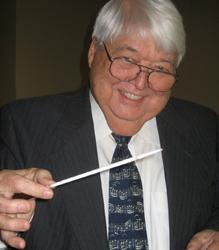
Melvin Dickinson, 77, died on January 31 in his beloved Bach Haus in Louisville, Kentucky, the result of a heart attack. A native of Todd County, Kentucky, Dickinson earned his bachelor’s and master’s degrees in music from the University of Kentucky, in Lexington. During these years, he served as assistant organist at Lexington’s Christ Church Cathedral (Episcopal).
Bach was the common ground that united Melvin and Margaret Leupold as they embarked on Fulbright fellowships in Frankfurt-am-Main, Germany, from 1958 to 1960. They studied with the Bach organ master Helmut Walcha and became his assistants as the blind Walcha concertized throughout Europe. The Bach bond became so strong that these two best friends were married in 1961, and formed the Bach Cantata Series at the Episcopal Church of the Ascension in Frankfort, Kentucky, where Mr. Dickinson served as organist-choirmaster for six years.
In 1964, he and his wife Margaret founded the Louisville Bach Society, continuing offerings of major choral-orchestral works of all centuries until 2011, all the while specializing in their first love, the oratorios, Masses, motets, and cantatas of Johann Sebastian Bach.
Melvin Dickinson was head of the organ and church music department at the University of Louisville for 42 years, retiring as Professor Emeritus in 2001. During that time, he taught and nurtured many students who now hold church music positions throughout the country, even extending to Singapore, Ireland, and Germany. He was a careful and meticulous teacher who never let a student get away with anything, all the while maintaining a cheerful and caring attitude and a wonderful sense of humor with a very sharp wit.
After his tenure at the Church of the Ascension, he assumed the same position at St. Francis in the Fields Episcopal Church, Louisville, from 1966–1979. His last choral move was to Calvary Episcopal Church, Louisville, from 1979–2012. Both Dickinsons were made Musicians Emeriti at Calvary in 2012. They continued to keep their minds active by presenting a monthly Bach Lecture-Recital series at the Bach Haus, the latest and final one being January 11, 2014.
Professor Dickinson received many awards in teaching, organ playing, and conducting during his decades-long devotion to excellent music. One of the more recent was the Kentucky Governor’s Award in the Arts in 2001, an individual artist award for lifetime achievement. His influence was far-reaching and prolific, and his Bach legacy will long be remembered and revered. He is survived by his wife, Margaret, with whom he made music for 52 years, two daughters, Maria (Joseph) and Michelle (John), and five granddaughters.
A memorial service was held February 8 at Calvary Episcopal Church, Louisville. Expressions of sympathy may take the form of contributions to the Calvary Episcopal Church Food Closet (821 S. Fourth St., Louisville, Kentucky 40203), or the Kentucky Bach Choir (Marlon Hurst, 239 Delmar Ave., Lexington, KY 40508).
—Stephen Schnurr

